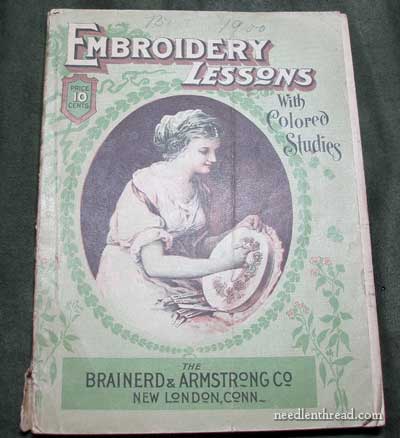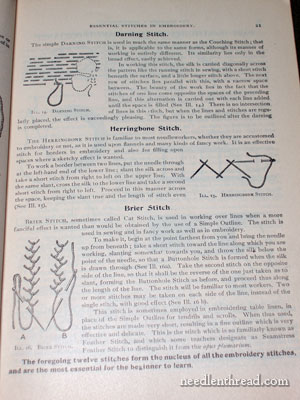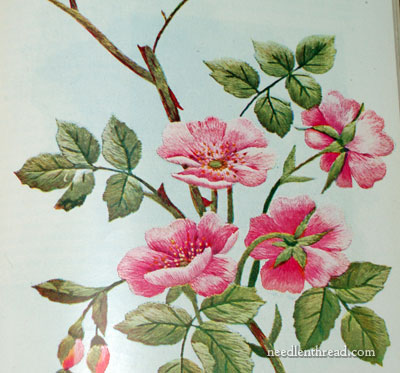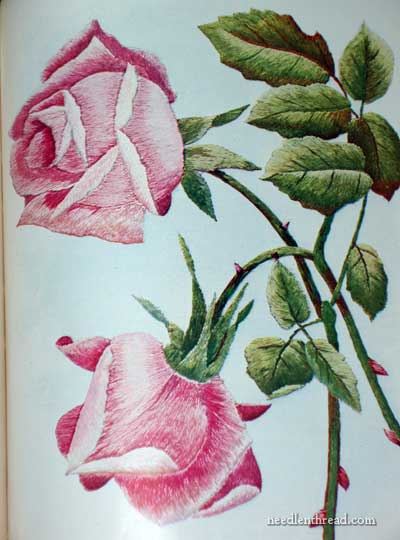At the dawn of the 1900’s, the companies that manufactured embroidery silk (known as filo and floss silks) published little manuals of instruction in hand embroidery that were also meant to be marketing tools.

One such company was the Brainerd & Armstrong Company out of New London, Connecticut. In 1899, they published a 140+ page instructional booklet called Embroidery Lessons with Colored Studies. It’s a fantastic little piece of embroidery history, focusing on Society (or Art) Silk Embroidery. I happen to have a copy of it, and when thumbing through it the other day, I found myself here and there chuckling, often nodding in agreement, and finally wondering why I hadn’t read through the whole book before.
I’ve already mentioned a little bit about Society Silk here on Needle ‘n Thread, so before showing you some tidbits from the book, I’ll refer you to a few previous posts if you want to know more about the type and era of embroidery that this little book focuses on:
- Vintage Embroidery Supplies – this includes pictures of supplies used for Society Silk embroidery
- Vintage Linens – this includes close-ups on the linens used for Society Silk embroidery
- Photo Resource for Society Silk – Links to an abundance of Society Silk embroidery photos online
- Society Silk Embroidery Revisited – another photo of a Society Silk embroidery piece plus some history on the subject and online resources
- Carnations in Silk – Margaret Cobliegh’s silk carnations in Society Silk style

One thing that must be kept in mind – and don’t worry, it will be! the publishers won’t let you forget! – is that these little books were meant not just for instruction but also as catalogs for goods. The publishers were out to sell the embroiderer their silk (not any other!). Advertisements abound – chiefly for Brainderd & Armstrong needlework supplies. Aside from advertisements, there are other subtle marketing tricks that might convince the needleworker to use Brainerd & Armstrong silks. The Introductory Hints section of the book begins with this emphatic statement:
For this particular book, Good Silk = Brainerd & Armstrong Silk. And you’re not allowed to forget this point as you learn your embroidery stitches! The instructional section on stitches ends with this emphatic statement:
Beware of the inferior silks which some dealers recommend (because they can make a larger profit if they can get anyone to buy them). Inferior silks run in washing and ruin your finished piece of embroidery. It is a waste of money to buy cheap, inferior silks. The safe way is to insist on having Brainerd & Armstrong’s Wash Silks. See that the name Brainerd & Armstrong is on the tag of every skein of silk you use.
And there you have it!
The marketing is so blatant that today, we might find it humorous. But on the other hand, are they saying anything untrue? I’ve never used Brainerd & Armstrong silks, though I have some, and they are lusciously beautiful, so they’ve withstood the test of time very well. But what they say about thread choice is legit: why waste money on inferior threads? why risk ruining your work with threads that run? (Keep in mind that Society Silk decorated household linens that were meant to be washed.)

The book has an extensive stitch dictionary. Notice anything different about the stitch dictionary at the turn of the 1900’s and the stitch dictionary of today? I was struck with the ratio of words to pictures – more words, fewer pictures. Today’s stitch dictionaries are the inverse.
The color plates in the book are accompanied by instruction on how to accomplish the particular colors and shadings featured in the plates. I like this particular picture of various stems:

The purpose of the exercise is to practice all different ways that stems can be stitched to look realistic.
Aside from the stems exercise, the majority of the plates focus on bunches of flowers, and they’re really very pretty!

This piece is titled “Fringed Gentian.” The catalog is not really a project book in the proper sense. Today, we buy embroidery books that cover a specific technique – instructions, supplies, and so forth are all covered in the book, as well as multiple projects that include the designs. With Society Silk, the embroiderer would look at a catalog such as this and pick out the doily or tea cloth she wanted to embroider, which she would then order from the company and it would come pre-stamped with the flowers. In short, the designs aren’t included in the catalog.

A bundle of beautiful cosmos, anyone? The silks used for this type of realistic needlepainting are really vibrant, beautiful silks, and the color range available was extensive. The embroiderer could achieve perfect and realistic shading on the flowers.

Here are some Society Silk wild roses. Now, if you wanted to come up with a similar design for embroidery from the plates in a catalog like this, you could do what Margaret Cobleigh did with her Silk Carnations. If you look at the embroidery pattern for the carnations, you can see what she did to make her pattern. Her finished carnations are beautiful!

The dandelion is not exactly my favorite growing thing in real life, but interpreted in embroidery, it’s attractive. The puffs on this one are perfect.

And then, of course, there’s the rose. The lower drooping rose in this piece is exquisite!
I hope you enjoyed this glimpse into embroidery of the past, specifically Society Silk. If you ever come across any of these old instructional catalogs, don’t hesitate to pick them up! They make entertaining reading, and you’re certain to glean a few excellent embroidery tips along the way!
For further reading on Society Silk on Needle ‘n Thread, here are those links again:
- Vintage Embroidery Supplies – this includes pictures of supplies used for Society Silk embroidery
- Vintage Linens – this includes close-ups on the linens used for Society Silk embroidery
- Photo Resource for Society Silk – Links to an abundance of Society Silk embroidery photos online
- Society Silk Embroidery Revisited – another photo of a Society Silk embroidery piece plus some history on the subject and online resources
- Carnations in Silk – Margaret Cobliegh’s silk carnations in Society Silk style







How cool it this book!!!!
Won’t stop raining in Michigan!
Looks like you have a little gem in this booklet! I love the old embroidery books. I love the new ones too, but there’s something about the old ones that I find so charming. Thanks for showing us this one!
Hi, all! Glad you like the book – I love it! It’s got some great tips and tricks in it, too – I’ll share some of them in bits and pieces now and then. Justine, yes – I LOVE Antique Pattern Library. I go there all the time. The only disadvantage of it is that it sucks me in, and I end up browsing for far too long! Mary Anne – the old ones are “charming,” I think!
Have a great evening!
MC
Thanks for the reminder, I have one or 2 of these booklets. Have you visited http://www.antiquepatternlibrary.org/completelist.htm? It’s a wonderful collection of scans of patterns and booklets now in the public domain. A lot of knitting/crochet/tatting but there is embroidery there too. Justine
Thanks for the guidance steering me through this new website Marymentor! 🙂 I absolutely LOVE that drooping rose and envy someone’s expertise in it’s shading. I’m still working on that but continue to forge on, undaunted, thanks to your encouragement…Again, Thanks Mary…JudyinPittsburgh
I have some of these, too, and in a 1907 copy three partial skeins of filo silk were tucked in the pages near a flower design. Really cool to be able to see for yourself what these long-ago stitchers were using. Your new website is terrific, by the way!
G’day Mary,
Just some quick catching up.
Was surprised at the quality of the colour pictures in this old book. Beautiful.
I too particularly love the stems sampler. Something about it ‘clicks’.
Also the Dandelion. Yes, it’s a pest in the garden but I love it. The ‘clocks’ are particularly good for photography in all their stages, especially with a dark background.
Thanks for the post.
Cheers, Kath
Thank you for this entry – as always it was interesting, informative, and well-written! The photos that you reprinted are beautiful! I have been reading your site and watching your videos for a long time but I don’t think I’ve ever posted.
I just wanted to point out that unfortunately, little has changed in the way that advertising pervades much of the information that is published about art techniques, especially in print magazines. Virtually every art/craft magazine I pick up, whether about needlework, sewing, mixed-media art, jewelry making, photography and even painting, contains instructions that specify the use of brand names, most often those of the companies that have advertisements in that issue. Sometimes I wonder about the “chicken and the egg” scenario that might take place in these editorial decisions. Are the articles luring the advertisers, or do the advertisers expect that part of of their deal with the publishers is that their products will be endorsed? Of course it is a tricky business, as writers who are artists will have their own preferred products and some products are so unique that certain projects couldn’t be replicated without them. These magazines usually consist mostly of “recipes” for projects and therefore have supply lists. (Hopefully they also contain artist profiles and photographs of inspiring work – those are usually my favorite sections). However, when reading “Gourmet” or “Bon Appetit”, I rarely see a recipe that specifies a certain brand of, say, spices or chicken. There are review sections in most magazines, and I appreciate reading the opinions of people who have tested and/or used certain products. For example, when I decided to purchase some linen when I was learning to cross-stitch, I checked here to see what you had to say about the subject (I still haven’t bought any Legacy linen, but it’s high on my Wish List!). I also often read customer reviews on sites like Amazon and check Consumer Reports before making big purchases. I like and rely on reviews, but I like to *know* that they are reviews!
Unfortunately, too many craft magazines stretch their recommendations of specific products across their pages, rather than limiting them to their “review” and “new products” pages. I have been saddened to see certain publications (one popular, and formerly great “mixed-media” magazine comes directly to mind) start out with solid articles and inspirational ideas and over time (and sometimes coinciding with changes in the editorial staff or purchase by a different publisher) become little more than thinly-veiled catalogs.
Of course most magazine (and websites) must rely on advertising, especially as digital delivery threatens subscriptions. However, aren’t the ads themselves enough? We see “product placement” becoming more and more prevalent in television and films and while that can be somewhat annoying if it gets in the way of plot-lines, at least we understand that it is a price we are paying for entertainment. While “how-to” magazines are entertaining to read, they are primarily a format for information and education. It would be nice if they tried for journalistic integrity.
The title you chose, “Lessons From the Past” is particularly apt as your article shows that there is a long history of combining information with advertising. I think we should all be alert that this practice is far from obsolete. On the contrary, it very much in practice and while it might be somewhat more subtle these days that only makes it more insidious.
Best Wishes,
-sam-
I found a Embroidery LESSON 1904 IN MY GRANDMOTHER box and Our 98 Book 1898
Very interesting. Looking back at the beautiful silk threads of then. I still have a few skeins left to me by an aunt. Don’t think the thread is still useable.
Buenas tardes.
Desde México. Preciosa las láminas aligual que su nutrida información.
Gracias.